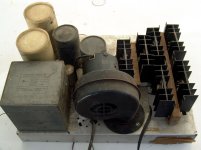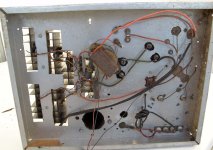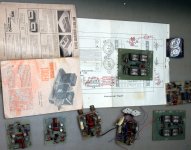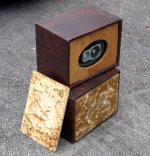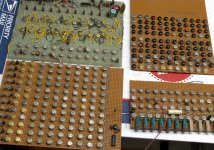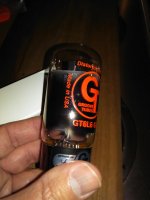I am currently riding in a car through the mountains with sporadic internet through a 5 year old phone. I will have more to post when I'm at a real computer, maybe tomorrow. In the mean time, anyone interested in starting down the road towards an audio business should read this:
Schiit Happened: The Story of the World's Most Improbable Start-Up
The same story is available from Amazon on Kindle for a few bucks.
It is a true story, and I can attest to hitting some of the same bumps in the road. The audio business IS cyclical, you sell very little in the summer. Vacuum
tube businesses suffer from "Buick Disease." I'll explain more later.
Schiit Happened: The Story of the World's Most Improbable Start-Up
The same story is available from Amazon on Kindle for a few bucks.
It is a true story, and I can attest to hitting some of the same bumps in the road. The audio business IS cyclical, you sell very little in the summer. Vacuum
tube businesses suffer from "Buick Disease." I'll explain more later.
Likewise. For many years assorted and various have bugged me to go commercial, I'm a tech, not an entrepreneur. If a word of mouth referral comes my way to repair or mod, I'll look into it. While I still have regular employment and limited tinkering time, not that interested. KevinKR's commentary is very thoughtful.
This is a topic I've been mulling over for a while and I've come to the same conclusion as many here and have been scared off from trying to make it more than a break-even hobby. But I wonder if there's a better way of doing it part time.
Building and selling enough amps to make a comfortable living requires a good brand (lots of marketing, time spent building brand equity) and a fairly high price mark-up (unless you go down the Schitt road of mass-production, but that seems to kill the fun of designing/building IMO). The need for a high mark-up is both due to 'real life' obligations (mortgage, bills, etc) as well as demand uncertainty and high parts cost and variability.
There are designs out there that are very well-established and respected (e.g. El Cheapo, Baby Huey, Tubelab's SE designs). These designs already have a certain amount of marketing value (e.g. search engine keywords) because they've been discussed and praised in many forums. Many of the top results if you google "stereo tube amp" are actually DIY projects, but for the average consumer they don't apply (because the average consumer is shopping, not researching building their own amp).
Well, what if these DIY designs were consumer products that could be made to order from local builders?
Get a network of builders together for work referral and organize them on a single website that serves both as advertisement of designs (with aforementioned existing marketing value) and connects consumers with their local tube builder. This has the advantage of pooling brand equity among many part-time builders and can drive down parts cost and variability through group buys and standardized builds. It might also help make demand more consistent: for example a large metro may have several builders and any orders go to whoever doesn't have a current project occupying them, rather then a bunch of orders landing on one person's bench. Kind of like how hosts seat patrons in sections at a restaurant.
Getting a group to agree on 'standard' designs and parts would be key to the effectiveness of the marketing power and that might be easier said than done. There are a lot of fine details that would need to be worked out (warranties, royalties to designers, employee vs independent contractor, turn around time, qualifications). I don't think anyone would get rich, but it could be a way to improve visibility for part-time builders and give them a little more consistent work. Decentralized boutique amplifier manufacturing service.
I don't know. Just an idea that I've been kicking around.
Building and selling enough amps to make a comfortable living requires a good brand (lots of marketing, time spent building brand equity) and a fairly high price mark-up (unless you go down the Schitt road of mass-production, but that seems to kill the fun of designing/building IMO). The need for a high mark-up is both due to 'real life' obligations (mortgage, bills, etc) as well as demand uncertainty and high parts cost and variability.
There are designs out there that are very well-established and respected (e.g. El Cheapo, Baby Huey, Tubelab's SE designs). These designs already have a certain amount of marketing value (e.g. search engine keywords) because they've been discussed and praised in many forums. Many of the top results if you google "stereo tube amp" are actually DIY projects, but for the average consumer they don't apply (because the average consumer is shopping, not researching building their own amp).
Well, what if these DIY designs were consumer products that could be made to order from local builders?
Get a network of builders together for work referral and organize them on a single website that serves both as advertisement of designs (with aforementioned existing marketing value) and connects consumers with their local tube builder. This has the advantage of pooling brand equity among many part-time builders and can drive down parts cost and variability through group buys and standardized builds. It might also help make demand more consistent: for example a large metro may have several builders and any orders go to whoever doesn't have a current project occupying them, rather then a bunch of orders landing on one person's bench. Kind of like how hosts seat patrons in sections at a restaurant.
Getting a group to agree on 'standard' designs and parts would be key to the effectiveness of the marketing power and that might be easier said than done. There are a lot of fine details that would need to be worked out (warranties, royalties to designers, employee vs independent contractor, turn around time, qualifications). I don't think anyone would get rich, but it could be a way to improve visibility for part-time builders and give them a little more consistent work. Decentralized boutique amplifier manufacturing service.
I don't know. Just an idea that I've been kicking around.
These designs already have a certain amount of marketing value (e.g. search engine keywords)
The search engine thing is good, but as I found out can nearly kill your company.
I designed a simple single ended amplifier, now called the SSE. I initially called it Simple followed by the common abbreviation for Single Ended. It became popular, and someone in a forum somewhere typed the name as one long word. That name bounced around the internet a few zillion times, and became associated with my amp.
That name just happens to be the trademarked name for a home theater product owned by another company that is neither simple, nor single ended. I got a registered letter from the CEO of said company politely asking that I refrain from using the single long word in reference to my amp, and I agreed. In turn they agreed not to have their "53 person legal team" squash me. I saved all the emails.
Three years later I get an angry summons from the big legal team. It seems that my little board would be in 5 to 7 of the top 10 hits when Googling for their trademarked product. They were understandably angry......My amp must now be referred to by its 3 letter abbreviation.
Carefully check for any and all manners of misspelling and mangling a name you are going to use for possible trademarks, before associating it with anything you post regarding your stuff.
Carefully check for any and all manners of misspelling and mangling a name you are going to use for possible trademarks, before associating it with anything you post regarding your stuff.
hmmm... perhaps I could amuse some attorneys and use my fast-food namesake; I can see my product line now...
"Two All Beef Patties, Special Sauce" stereo amplifier
"Super Size That?" 5-way all horn loaded speaker system
"Shamrock Shatki" stones
"Filet o'Filter" AC line conditioner
ok, ok, I'll stop now
A guy was forced recently to replace his custom registration plates on the car because hist last name sounds like something political. His last name is Grabher.
I have been making HiFi and guitar amps ever since the 60's. Usually I built something I liked, used it until I built something I liked better, then sold or gave away the old one. My friends often asked me to fix their HiFi, stereo, guitar amp, or CB radio equipment, and sometimes even paid me to do so.
I would visit the local trash dump (landfill) where I could get tubes and parts for free out of discarded TV’s, radios and HiFi equipment. I occasionally found something in good enough condition to bring home and fix.
Somewhere around age 14 I was introduced to the art of dumpster diving behind the local Japanese electronics importers and manufacturing shops. Here was brand new stuff, usually physically damaged, but often one good unit could be made from 2 or 3 broken ones. The local Lafayette Radio, and Olson Electronics stores would sell me their defective stuff, which I would fix and sell at high school. I had collected about 50 pounds of scrapped circuit boards from the dumpster behind Coulter Electronics (medical electronics, mostly blood counters).
This got me a job at a TV repair shop at age 15, and as the service tech at Olson at 18 (1971). By this time I had built myself a 200 Watt vacuum tube guitar amp, with a pair of 4 X 12 inch DIY speaker cabinets. I had also made a solid state “booster amp” that I fed with a Fender Champ clone that put out about 300 watts RMS at an unknown level of distortion (clean enough to play music though when driven by a HiFi amp). The scrap Coulter boards yielded enough primitive RTL logic chips for me to embark on the design and construction of a digital music synthesizer in 1971, after attending an ELP concert.
In 1973 at age 20, I got a job at Motorola where there were thousands of technical people that listened to music or played a musical instrument. There was even an "audio club" which built stuff, mostly solid state. This was always a hobby, but there were periods of time when a lot of amps got built, and some were sold. The most prolific period was in the late 70's when myself and several other technical people at Motorola made "clones" of just about everything interesting in the SWTPC catalog including the MC6800 based computer.
My HiFi amps were tube and solid state, but most of my guitar amps used tubes. Throughout the 80's I had a Carver / Phase Linear stereo system, which was a byproduct of the old Motorola audio club. It would be my stereo system for at least 10 years.
Family obligations reduced my audio involvement to casual listening, no amps were built for years, my only remaining guitar had been stolen, and I had sold all of my synthesizer stuff. My hobby interests were mostly photography and computers (TRS80 and Apple ][ clones). There were occasional "commercial" activities, like board kits for the SS50 bus used in the SWTPC computer, and satellite TV receiver kits (DMA Engineering) and PIC based gizmos (G&S programming) but neither lasted more than a few years
Then one day a friend traded me a Mosrite guitar and a POS solid state amp for an RF amplifier that I had built, and another friend traded me an old Scott EL34 based stereo system for my first car, which was still parked in my yard after 30 years (still running, legally registered, and occasionally driven). I replaced two broken resistors and a tube in the Scott, and within a week the Carver stuff hit the closet. I made a better guitar amp (solid state) and gave away the POS. It took me about a month to clone the Scott, but I never got to use the clone. I loaned it to a friend who bought it.....repeat, a few times, often with KT88’s.
Then I decided to build a SE amp using some old DHT's that I had, just to see what all the commotion was about, and another, and before I knew it I was making amps again. By this time my daughter was in the high school band, and she wanted to play the guitar, so I made her an amp, then one for her friend, and another. This would start something that is still going on.
I have no pictures from the "early years." My parents had a Kodak Instamatic camera, but rarely pointed it at me. My musical adventures were not appreciated (especially the rock band) and the electronics were tolerated since I did fix stuff, and everybody in the house had their own free radio and TV from my adventures.
While cleaning out my house several years ago, I found some old reminders. The 300 watt "booster amp," the hand wired perf boards from my 1971 - 1973 music synthesizer experiments, and a pair of DIY speaker cabinets had followed me around through several moves until they wound up in a shed behind the house I lived in for 36 years.
The booster amp fried when I plugged it in. One of the big electrolytics was shorted, so I took several pictures, then jumped the fuse and watched it fry, then trashed it.
One of my brothers and I made speaker cabinets in the back yard at my parents house during our high school years. Some were HiFi, most were guitar, and a few were "thumpers" (now called subwoofers). We stuffed a cheap Eminence made Olson 15 inch driver in a 4 cubic foot plywood box, covered them with naugahyde and crushed velvet we got from the dumpster at a bean bag and waterbed factory, and sold them to the Latin dance crowd.
I also made some small cabinets for guitar and stereo use with 6 X 9 inch car drivers. I had a pair in my car for "blasting" at the beach. Set them on the roof of the Dodge Dart, and crank it up. One pair survived until I photographed them, and "tested" them. The foam surround in the Jensen drivers lasted about 5 seconds when I connected a guitar amp up and cut loose. They were trashed. The large digital music synthesizer project I had started in 1971 was never finished, but did get far enough along to make music. When I got the job at Motorola, I didn't have the time to finish it, but I had the money to but and ARP Odyssey, and a few other toys. I could not bring myself to just trash something that took almost 2 years to build, so I saved the main boards. I still have them. I plan to power them up, but I don't expect much from 50 year old IC chips.
Enclosed are two pictures from the booster amp that I made in high school. Note the wood and nibbled out aluminum chassis construction. The chassis were Allied Electronics mail order which were actually Hammond as were their transformers. Allied is still around and still selling Allied branded Hammond transformers. My early guitar and HiFi amps used similar construction, although my techniques improved slowly over the 50 years.
I found a box full of leftover parts from the SWPTC cloning days.
The pair of speakers before "death by guitar amp."
The boards from my 1971 vintage digital music synthesizer. Each round metal (Motorola) or black plastic (Fairchild) can is an 8 pin round IC chip. Each chip is a single logic gate (NAND, NOR, or Flip Flop). It takes a lot of chips and wiring to make a simple digital design. The green board is a Top Octave Generator, similar to the Mostek MK50240 that would come along about 10 years later. The other boards are also tone generators.
More history to come
I would visit the local trash dump (landfill) where I could get tubes and parts for free out of discarded TV’s, radios and HiFi equipment. I occasionally found something in good enough condition to bring home and fix.
Somewhere around age 14 I was introduced to the art of dumpster diving behind the local Japanese electronics importers and manufacturing shops. Here was brand new stuff, usually physically damaged, but often one good unit could be made from 2 or 3 broken ones. The local Lafayette Radio, and Olson Electronics stores would sell me their defective stuff, which I would fix and sell at high school. I had collected about 50 pounds of scrapped circuit boards from the dumpster behind Coulter Electronics (medical electronics, mostly blood counters).
This got me a job at a TV repair shop at age 15, and as the service tech at Olson at 18 (1971). By this time I had built myself a 200 Watt vacuum tube guitar amp, with a pair of 4 X 12 inch DIY speaker cabinets. I had also made a solid state “booster amp” that I fed with a Fender Champ clone that put out about 300 watts RMS at an unknown level of distortion (clean enough to play music though when driven by a HiFi amp). The scrap Coulter boards yielded enough primitive RTL logic chips for me to embark on the design and construction of a digital music synthesizer in 1971, after attending an ELP concert.
In 1973 at age 20, I got a job at Motorola where there were thousands of technical people that listened to music or played a musical instrument. There was even an "audio club" which built stuff, mostly solid state. This was always a hobby, but there were periods of time when a lot of amps got built, and some were sold. The most prolific period was in the late 70's when myself and several other technical people at Motorola made "clones" of just about everything interesting in the SWTPC catalog including the MC6800 based computer.
My HiFi amps were tube and solid state, but most of my guitar amps used tubes. Throughout the 80's I had a Carver / Phase Linear stereo system, which was a byproduct of the old Motorola audio club. It would be my stereo system for at least 10 years.
Family obligations reduced my audio involvement to casual listening, no amps were built for years, my only remaining guitar had been stolen, and I had sold all of my synthesizer stuff. My hobby interests were mostly photography and computers (TRS80 and Apple ][ clones). There were occasional "commercial" activities, like board kits for the SS50 bus used in the SWTPC computer, and satellite TV receiver kits (DMA Engineering) and PIC based gizmos (G&S programming) but neither lasted more than a few years
Then one day a friend traded me a Mosrite guitar and a POS solid state amp for an RF amplifier that I had built, and another friend traded me an old Scott EL34 based stereo system for my first car, which was still parked in my yard after 30 years (still running, legally registered, and occasionally driven). I replaced two broken resistors and a tube in the Scott, and within a week the Carver stuff hit the closet. I made a better guitar amp (solid state) and gave away the POS. It took me about a month to clone the Scott, but I never got to use the clone. I loaned it to a friend who bought it.....repeat, a few times, often with KT88’s.
Then I decided to build a SE amp using some old DHT's that I had, just to see what all the commotion was about, and another, and before I knew it I was making amps again. By this time my daughter was in the high school band, and she wanted to play the guitar, so I made her an amp, then one for her friend, and another. This would start something that is still going on.
I have no pictures from the "early years." My parents had a Kodak Instamatic camera, but rarely pointed it at me. My musical adventures were not appreciated (especially the rock band) and the electronics were tolerated since I did fix stuff, and everybody in the house had their own free radio and TV from my adventures.
While cleaning out my house several years ago, I found some old reminders. The 300 watt "booster amp," the hand wired perf boards from my 1971 - 1973 music synthesizer experiments, and a pair of DIY speaker cabinets had followed me around through several moves until they wound up in a shed behind the house I lived in for 36 years.
The booster amp fried when I plugged it in. One of the big electrolytics was shorted, so I took several pictures, then jumped the fuse and watched it fry, then trashed it.
One of my brothers and I made speaker cabinets in the back yard at my parents house during our high school years. Some were HiFi, most were guitar, and a few were "thumpers" (now called subwoofers). We stuffed a cheap Eminence made Olson 15 inch driver in a 4 cubic foot plywood box, covered them with naugahyde and crushed velvet we got from the dumpster at a bean bag and waterbed factory, and sold them to the Latin dance crowd.
I also made some small cabinets for guitar and stereo use with 6 X 9 inch car drivers. I had a pair in my car for "blasting" at the beach. Set them on the roof of the Dodge Dart, and crank it up. One pair survived until I photographed them, and "tested" them. The foam surround in the Jensen drivers lasted about 5 seconds when I connected a guitar amp up and cut loose. They were trashed. The large digital music synthesizer project I had started in 1971 was never finished, but did get far enough along to make music. When I got the job at Motorola, I didn't have the time to finish it, but I had the money to but and ARP Odyssey, and a few other toys. I could not bring myself to just trash something that took almost 2 years to build, so I saved the main boards. I still have them. I plan to power them up, but I don't expect much from 50 year old IC chips.
Enclosed are two pictures from the booster amp that I made in high school. Note the wood and nibbled out aluminum chassis construction. The chassis were Allied Electronics mail order which were actually Hammond as were their transformers. Allied is still around and still selling Allied branded Hammond transformers. My early guitar and HiFi amps used similar construction, although my techniques improved slowly over the 50 years.
I found a box full of leftover parts from the SWPTC cloning days.
The pair of speakers before "death by guitar amp."
The boards from my 1971 vintage digital music synthesizer. Each round metal (Motorola) or black plastic (Fairchild) can is an 8 pin round IC chip. Each chip is a single logic gate (NAND, NOR, or Flip Flop). It takes a lot of chips and wiring to make a simple digital design. The green board is a Top Octave Generator, similar to the Mostek MK50240 that would come along about 10 years later. The other boards are also tone generators.
More history to come
Attachments
Last edited:
The tube amplifier "renaissance" depended on ample disposable income for its existence. Now that our claptrap tweeting president has reversed the arrow of time, we will be becoming the technology leaders in coal stoves and buggy whips. Technology development for future essential world trade leadership will be sacrificed in the name of jobs right now, jobs for lawyers and coal miners. Except maybe for tube related repair businesses, the tube show is over. There aren't any good tubes left anyway. You would be better off writing an historical nostalgia book about the tube amp era.
Good luck Wavebourn, tubelab and thank you for the stories.
btw I found this inspiring:
I saw this new canadian company: Finale Audio Canada
it shows the real price of built in America audio...
I think their products are beautiful. We will see if they succeed.
6000$ for their el84 integrated amplifier
I had requests for 100 to 1000 watts tube amplifiers for 100$ hehe.
I design my amplifiers for my own taste and to drive Harbeth's exclusively, I try to keep as far as possible from the 'triode' and DHT sounds, the idea is to go beyond what the good solid state amplifiers do well, to achieve something like Accuphase did.
btw I found this inspiring:
I saw this new canadian company: Finale Audio Canada
it shows the real price of built in America audio...
I think their products are beautiful. We will see if they succeed.
6000$ for their el84 integrated amplifier
I had requests for 100 to 1000 watts tube amplifiers for 100$ hehe.
I design my amplifiers for my own taste and to drive Harbeth's exclusively, I try to keep as far as possible from the 'triode' and DHT sounds, the idea is to go beyond what the good solid state amplifiers do well, to achieve something like Accuphase did.
 Posts with political content have been removed per forum rules. Please don't post political commentary here.
Posts with political content have been removed per forum rules. Please don't post political commentary here.Improved tubes with impressive linearity need to be developed, not copies of 70 year old ones.
..
I'll take a wild guess that you can have the environment, profit, or vacuum tubes.
Pick two.
Attachments
My suspicion is that the physics and practical aspect of tube manufacture means we reached the highest achievable level of linearity in types that required it many decades ago.
Look at types like the D3A, C3G, or E810F if you want linear.
I imagine that from an environmental perspective manufacturing tubes is probably not any worse than (maybe not nearly as bad as) large scale semiconductor manufacturing, and undoubtedly uses much less water. Managing energy use and toxic waste disposal are probably amongst the biggest issues.
Look at types like the D3A, C3G, or E810F if you want linear.
I imagine that from an environmental perspective manufacturing tubes is probably not any worse than (maybe not nearly as bad as) large scale semiconductor manufacturing, and undoubtedly uses much less water. Managing energy use and toxic waste disposal are probably amongst the biggest issues.
Hi Kevin,
I can't help but to agree with you. The tube industry has been stable for decades now. The only improvements I could see would be new materials for use in tubes. The physics are pretty much nailed right down.
Copying 70 year old designs that were already correct from a mechanical standpoint can only been improved by materials. The current 12AX7A copy from New Sensor (12AX7EH) has the improved materials and technology (spiral heater for lower hum). So that tube is right up to date and isn't just a copy of a 70 year old tube design. That and manufacturing processes are well under control as they have less unit to unit variances than ever before.
What's there not to like about this??
-Chris
I can't help but to agree with you. The tube industry has been stable for decades now. The only improvements I could see would be new materials for use in tubes. The physics are pretty much nailed right down.
Copying 70 year old designs that were already correct from a mechanical standpoint can only been improved by materials. The current 12AX7A copy from New Sensor (12AX7EH) has the improved materials and technology (spiral heater for lower hum). So that tube is right up to date and isn't just a copy of a 70 year old tube design. That and manufacturing processes are well under control as they have less unit to unit variances than ever before.
What's there not to like about this??
-Chris
Don't forget that consuming NOS products means less demand for new manufacturing. Any harm from the manufacturing of NOS tubes is already done long ago. Might as well put them to use (in as efficient designs as possible, of course).
The spiral heater saw first application in a 12AX7 variant (RCA 7025) more than 5.5 decades ago. Good NOS examples now go for obscene money. (There were probably other spiral filament tubes from Western and Northern Electric well before this.)
At this point there is almost nothing new under the sun in tube technology, but the Russians continued to develop new types well after the end of such activities in the West.
The cutting edge makers these days are probably outfits like EML and Kron which specialize in a variety of DHTs many of which have no vintage analogs.
Finding good sources of tubes is a potential risk. Using unpopular but well performing types is one possible solution until supplies are exhausted; while very cheap in many instances these tubes often incorporate advanced technology and fabrication techniques now lost to time, and which therefore will never be made again. (Most often the case with late European post office tubes and Russian military surplus.)
At this point there is almost nothing new under the sun in tube technology, but the Russians continued to develop new types well after the end of such activities in the West.
The cutting edge makers these days are probably outfits like EML and Kron which specialize in a variety of DHTs many of which have no vintage analogs.
Finding good sources of tubes is a potential risk. Using unpopular but well performing types is one possible solution until supplies are exhausted; while very cheap in many instances these tubes often incorporate advanced technology and fabrication techniques now lost to time, and which therefore will never be made again. (Most often the case with late European post office tubes and Russian military surplus.)
Kevin;
if you mean Gu-50 military surplus, they are indestructible. And Chinese FU-50 are available.
4P1L are popular last several years, but prices are still low, compared to modern production tubes like KT-150, for example.
if you mean Gu-50 military surplus, they are indestructible. And Chinese FU-50 are available.
4P1L are popular last several years, but prices are still low, compared to modern production tubes like KT-150, for example.
Good luck Wavebourn, tubelab and thank you for the stories.
btw I found this inspiring:
I saw this new canadian company: Finale Audio Canada
it shows the real price of built in America audio...
I think their products are beautiful. We will see if they succeed.
6000$ for their el84 integrated amplifier
I had requests for 100 to 1000 watts tube amplifiers for 100$ hehe.
Yes, may be it is the way to go, to use fancy well advertised parts, claiming like 5.7W from a single EL84 tube...
- Status
- Not open for further replies.
- Home
- Amplifiers
- Tubes / Valves
- Making a living out of tubes? (A little off-topic)
